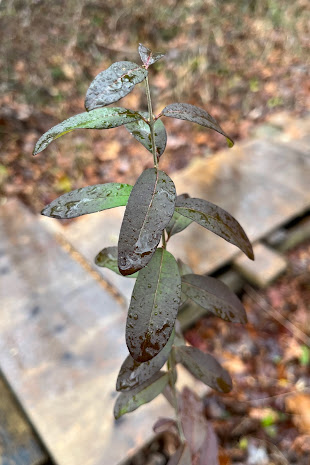One ongoing self-observation that I've had through a life of nature observation is that there are some plant names that resiliently spring to mind, and others that remain persistently unretrievable no matter how many times I learn and relearn them. For example, the latin names Gleditsia triacanthos and Robinia pseudoacacia look esoteric and intimidating, and yet for some reason I can summon them instantly. They refer to honey locust and black locust, respectfully, though I don't knowingly have any deeper interest in or respect or affection for these two trees than any others. Well, that's not completely true. I love black locust because it resists rot and burns clean. It can lie on the ground for years and still make great firewood. And a thornless version of honey locust makes a wonderful shade tree in public squares, its tiny leaflets melting back into the landscape in the fall. But I love other trees for their traits just as much. Gleditsia and Robinia, then, are two trees among many in my mind, and yet their names remain buoyantly floating above the others, at the top of the heap and the tip of the tongue.
At the other extreme lies fennel, a delicious, fragrant vegetable that grows gloriously. A friend made a casserole with fennel and leeks wrapped with prosciutto, the cheese on top baked to a golden brown. It was to die for, and yet the word "fennel" still dropped down into the cerebral abyss, dredged back up just now only by once again googling "plant that tastes like licorice." Similarly, there's a kind of lightbulb whose name I can never remember. The others come dependably and quickly to mind: florescent, incandescent, LED, mercury vapor. But the other one ... I think it starts with an "a" but I could be wrong. That's right. I was wrong, again. Had to google. It starts with an "h," as in "halogen."
What's the difference here? Gleditsia and Robinia make a merry, musical pair, both with impactful accents on the second syllable: gle-DIT-see-a and ro-BIN-ee-a. Fennel and halogen are less musical, with the accent landing heavily on the first syllable, like tunnel, or funnel, or allergen, or estrogen, or pathogen. But "merry" and "musical" also have the accent at the beginning, so maybe it's that the words "fennel" and "halogen" get less merry and musical after the first syllable, with consonants that are soft and easily swallowed up. I often think about this when comparing the names "Veblen" and "Einstein." Einstein has a memorably sonorous name that can be drawn out deliciously when spoken, like a double exclamation point, fitting for his matchless legacy. Veblen, on the other hand, whose quietly extraordinary career flew under most people's radar, then was long left for forgotten, has a name with soft consonants and indistinct vowels that are all too easy to mumble.
There's a belief that forgetting someone's name reflects a negative view of that person, but I find I can just as easily forget the name of someone I have just met and like. Next time that happens I'll pay attention to the sound of the name itself. It's fun to explore these things, and maybe the act of writing this will create an inner web of meaning to catch "fennel" and "halogen" before they once again drop into the abyss.




